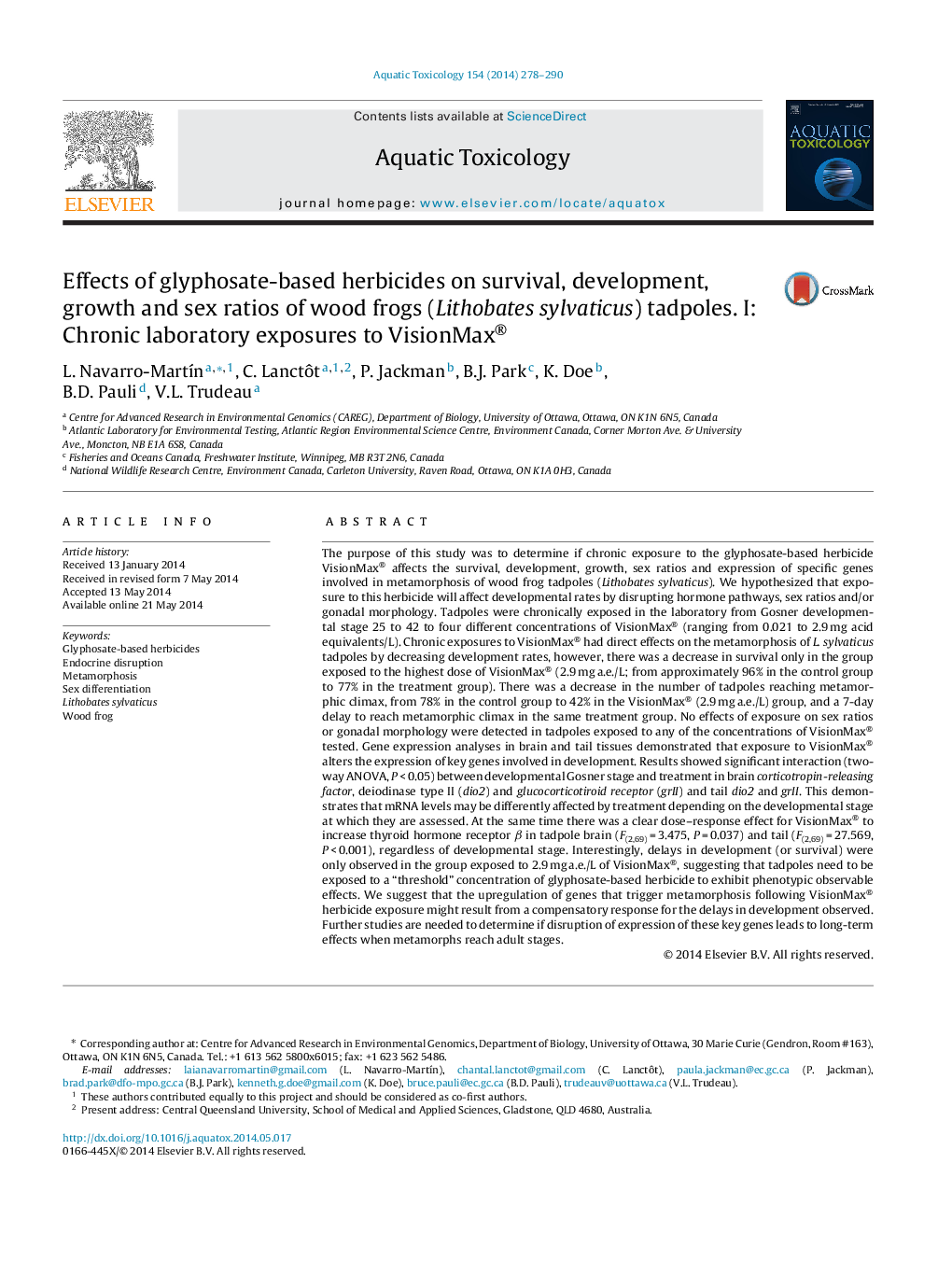| کد مقاله | کد نشریه | سال انتشار | مقاله انگلیسی | نسخه تمام متن |
|---|---|---|---|---|
| 4529227 | 1625951 | 2014 | 13 صفحه PDF | دانلود رایگان |

• Laboratory chronic exposures to VisionMax® affect metamorphosis of L. sylvaticus tadpoles.
• Chronic exposure to VisionMax® decrease development rates and metamorphic success.
• Exposure to VisionMax® alters the expression patterns of thyroid- and stress-related genes.
• No effects of VisionMax® exposure on sex ratios or gonadal morphology were observed.
• Further studies are needed to determine if long-term effects will be present during adulthood.
The purpose of this study was to determine if chronic exposure to the glyphosate-based herbicide VisionMax® affects the survival, development, growth, sex ratios and expression of specific genes involved in metamorphosis of wood frog tadpoles (Lithobates sylvaticus). We hypothesized that exposure to this herbicide will affect developmental rates by disrupting hormone pathways, sex ratios and/or gonadal morphology. Tadpoles were chronically exposed in the laboratory from Gosner developmental stage 25 to 42 to four different concentrations of VisionMax® (ranging from 0.021 to 2.9 mg acid equivalents/L). Chronic exposures to VisionMax® had direct effects on the metamorphosis of L. sylvaticus tadpoles by decreasing development rates, however, there was a decrease in survival only in the group exposed to the highest dose of VisionMax® (2.9 mg a.e./L; from approximately 96% in the control group to 77% in the treatment group). There was a decrease in the number of tadpoles reaching metamorphic climax, from 78% in the control group to 42% in the VisionMax® (2.9 mg a.e./L) group, and a 7-day delay to reach metamorphic climax in the same treatment group. No effects of exposure on sex ratios or gonadal morphology were detected in tadpoles exposed to any of the concentrations of VisionMax® tested. Gene expression analyses in brain and tail tissues demonstrated that exposure to VisionMax® alters the expression of key genes involved in development. Results showed significant interaction (two-way ANOVA, P < 0.05) between developmental Gosner stage and treatment in brain corticotropin-releasing factor, deiodinase type II (dio2) and glucocorticotiroid receptor (grII) and tail dio2 and grII. This demonstrates that mRNA levels may be differently affected by treatment depending on the developmental stage at which they are assessed. At the same time there was a clear dose–response effect for VisionMax® to increase thyroid hormone receptor β in tadpole brain (F(2,69) = 3.475, P = 0.037) and tail (F(2,69) = 27.569, P < 0.001), regardless of developmental stage. Interestingly, delays in development (or survival) were only observed in the group exposed to 2.9 mg a.e./L of VisionMax®, suggesting that tadpoles need to be exposed to a “threshold” concentration of glyphosate-based herbicide to exhibit phenotypic observable effects. We suggest that the upregulation of genes that trigger metamorphosis following VisionMax® herbicide exposure might result from a compensatory response for the delays in development observed. Further studies are needed to determine if disruption of expression of these key genes leads to long-term effects when metamorphs reach adult stages.
Journal: Aquatic Toxicology - Volume 154, September 2014, Pages 278–290